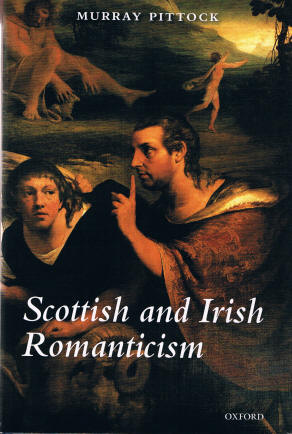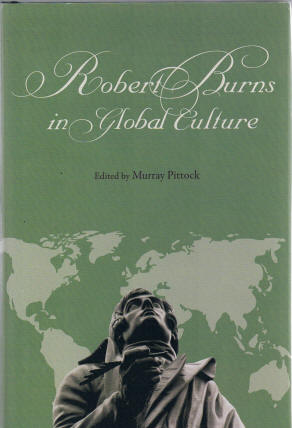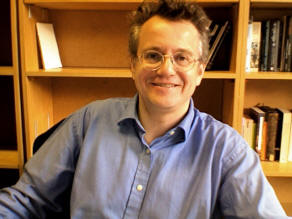|
Edited
by Frank R. Shaw, FSA Scot, Dawsonville, GA, USA
Email:
jurascot@earthlink.net
I am
sitting at my desk admiring two great books published by Murray Pittock -
Scottish and Irish Romanticism and Robert Burns in Global Culture. To study
reviews of both books, I refer you to Chapters 97 (September 2, 2010) and
127 (November 30, 2011) in the index of Robert Burns Lives!. Both will make
clear, in my opinion, that Murray Pittock is one of the top Burns scholars
in the world.


Murray is
one of an excellent and exciting group of Burns scholars at the University
of Glasgow. It is a team of extremely talented men and women dedicated to
seeing that Robert Burns regains his rightful place in literature. I can
safely say, from my point of view as well as that of a £1 million pound
windfall to the university’s Centre for Robert Burns Studies announced last
year, that they will succeed in this endeavor. These University of Glasgow
folks are, however, not alone in this quest. I am acquainted with other
literary scholars at St Andrews, Aberdeen, Edinburgh and other colleges and
universities in Scotland, as well as in the United States and Canada, who
will no longer allow the long and lowly accepted status quo of Robert Burns
to remain as we know it today. They are writing and seeking every chance
they get to tell the world that Robert Burns will recapture his place in the
academic community as a leader, not one who has been forgotten, overlooked
or replaced in the annals of the Romantic era.
Books like the two mentioned above and those listed in Murray’s article
below, along with some head turners to soon be published, The Cambridge
Companion to Scottish Literature (20 critical studies), Scotland and the
Nineteenth Century World (another collection of critical essays), and a
revised Burns Encyclopedia, will help restore Burns to his literary
greatness. The good news about these men and women is that their works will
continue to press the theme that Burns belongs in the forefront of
literature and that they will not be content for him to be seen only as a
village poet, “the heaven-taught ploughman”.
In the Introduction to
his Edinburgh Companion To Robert Burns Gerard Carruthers, on page 3
writes "...in the twenty-first century, arguably, we are of the verge of
a new and exciting phase of Burns criticism and scholarship. The intense
renewed interest in Burns's work and also in his whole cultural
afterlife and hinterland during 2009 suggests this is the case."
Also, in the Endnote of
the Introduction to his book Professor Carruthers states "Numerous
exhibitions and publications in this year (2009, my insertion), also
show the popular interest to be as great as ever and the scholarly
attention to be increasing."
That was three years ago
and now we find both the popular interest and scholarly attention to
have increased even more as new books of criticisms of the works of
Burns and his life are regulary printed with many more on the way. It is
indeed a fasicinating time to be a student of Burns.
Welcome back, Murray, you are always welcome to the pages of Robert Burns
Lives! And a happy Fourth of July to one and all on both sides of the pond!
(FRS: 7.4.12)
NOTE:
Murray Pittock is Bradley Professor of English Literature at the University
of Glasgow and a co-editor of the Oxford Burns edition. He has run several
funded Burns-related projects, including the 2009 Global Burns Network, and
is the author of Scottish and Irish Romanticism (2008) and many other books:
he has edited Robert Burns in Global Culture (2011) and The Reception of
Robert Burns in Europe (forthcoming). You can read more about Burns and
language in ‘To a Louse’ and other poems in Sergeant and Stafford, Burns and
Other Poets (2012).
Fiddling with Known Burns: Burns and the Limits of Criticism
By Murray Pittock

Professor Murray Pittock
There has
been a lot of recent publicity - and rightly so - about the new Burns
edition, which is being directed by Professor Gerard Carruthers with a
Glasgow-based team at the Centre for Robert Burns Studies. I’m really
pleased to be undertaking the challenging task of editing the Scots
Musical Museum for this edition, which will for the first time edit the
whole Museum of 600 songs and will examine in detail the range of
Burns’s interactions with this important collection. I hope to be able to
share some of the ‘biographies’ of the songs as they progress with readers
of the Club’s Newsletter and other interested Burnsians. One of the things
about the new edition that I’m proudest of is the extent to which it is
committed to engaging with the wider Burns community. Although all of our
editors, Centre members and supporting team have been committed in the long
term to celebrating and studying Burns at every level (I was very pleased in
that capacity to be asked to write the Foreword for Clark McGinn’s
Ultimate Burns Supper guide, which my wife illustrated), we are also
very conscious that the academic world as a whole has let Burns down since
1945. Let’s put that right together.
There have been substantial gains in recent Burns criticism. The new Oxford
University Press collected Burns is a major coup, as is its £1M first
tranche of funding. There are also a number of books placing Burns on an
international stage, including Nigel Leask’s prize-winning Burns and
Pastoral and powerful collections of essays such as Fickle Man,
The Edinburgh Companion to Robert Burns, Robert Burns in Global
Culture, Burns and Other Poets and Robert Burns in
Transatlantic Culture. Further ahead there is an Oxford Companion and
The Reception of Robert Burns in Europe. In the context of these and
other publications, the brief essay which follows suggests four elements of
a future campaign to restore Burns securely to his proper place as a poet of
remarkable complexity.
First, Burns was routinely incorporated in Romanticism until the Second
World War, when he was not being compared to Shakespeare. He was often
paired with Blake, and-as I argued in the 2002 British Academy Chatterton
lecture-enjoyed a level of critical interest fully in line with the rest of
the Big Seven Romantic poets. In 1982, Andrew Noble took up the comparison
between Burns and Blake again, while in 1998 Kenneth Johnston in The
Hidden Wordsworth made perhaps the first detailed case in modern times
for the importance of both Burns’ poetic theory and practice to Wordsworth.
In 2000, Fiona Stafford subtly presented Burns as both incorporating and
writing back against canonical English poetry. Others, including Nigel Leask,
Robert Crawford and myself, have extended this argument. Working together,
we can help to insert Burns back in a British canon, and in so doing, attain
richer readings of Wordsworth, Byron, Keats and other Romantic writers. This
is the first element in securing Burns’ reputation, and Fiona Stafford’s
recent work in Local Attachments (winner of the British Academy
Crawshay Prize) and Burns and Other Poets has been undertaking it.
Secondly, there is the question of language and text. The basic argument I
would advance is that whether we call Burns’ Scots a dialect or a language,
scholars have perhaps been too ready to read Burns through glossaries rather
than dictionaries, thesauruses and histories. The first step in developing a
critical approach to Burns’ language is to ensure it is addressed in terms
which protect Burns from the categorization of ‘labouring class poet’, not
because it is useful to have a socio-economic debate about Burns’
background, but rather because this term and its near synonyms have become a
shorthand for defending apparent limitations of vocabulary and a lack of
flexibility in language use more generally. Burns had a very large
vocabulary, and one where register and code switching (as Tom Crawford
noticed as long ago as 1960) have a large and significant part to play. To
see his linguistic choices as the outcome of a paucity of resources is the
exact opposite of the truth. Quite simply, reading Burns with the resources
of a more heavyweight dictionary or thesaurus to hand amplifies our
understanding of exactly the choices he is making. He uses not only general
Scots, but also north-eastern Scots (possibly/probably derived from his
father) and also south-western Scots. Sometimes when he seems to use Scots
English, his choice of language carries a further implication in Scots.
Let us take a few lines from ‘To a Louse’ as an example of this:
Now haud you there! ye're out o' sight,
Below the fatt'rils, snug an tight,
Na, faith ye yet! ye'll no be right,
Till ye've got on it--
The vera tapmost, tow'rin height
O' Miss's bonnet.
My sooth! right bauld ye set your nose out,
As plump an grey as onie grozet:
O for some rank, mercurial rozet,
Or fell, red smeddum,
I'd gie you sic a hearty dose o't,
Wad dress your droddum!
‘Fatt’rels’ are ribbons, or anything loose and trailing; but ‘fatter’ is
also a Dumfriesshire verb meaning to thresh the beards of barley:
connotatively, this may be the louse’s harvest. ‘The vera tapmost, towrin
height/ O’ Miss’s bonnet’ seems a simple enough description in Scots
English: but then ‘tap’ exists as a verb in Scots-and to English, as in ‘I
tapped him for a fiver’- meaning ‘to beg’, and as an adjective can refer to
a crest or feathers on a hat or to a plant tuft: thus even here the idea of
harvest, the metonymic vanity of the Lunardi bonnet and perhaps an outlying
association with theme of beggary may be being hinted at. ‘Grozet’ is a
gooseberry, but ‘grozet fairs’ were also held in Kilmarnock and Ayr in
gooseberry season, so Burns may have had in mind the connotations of
trading, carnival and carnality. The ‘rozet’ and ‘smeddum’ which the speaker
wishes he could visit on the louse would ‘dress your droddum’ (‘give you a
thrashing’): this is again North-Eastern Scots. ‘Rozet’ is resin, but
particularly that resin used on a fiddle-bow: an interesting conceit about
poetic composition as exorcising the louse hovers on the edge of the range
of available meanings here, while although ‘red smeddum’ is a specific
mercury-derived insecticide,. ‘smeddum’ itself is primarily used of ground
barley-meal or malt, extending the feeding/harvesting metaphor.
Almost any example of Burns’ use of Scots can be unpacked to create multiple
denotative meanings and an expanded connotative field beyond them. In ‘To a
Louse’, the connotations repeatedly lead us back to feeding and harvesting:
beneath the Smithian metaphor of the poem with its ‘Wad some pow’r the
giftie gie us’, lies not only the voyeurism of a narrator ignoring a Kirk
service to ogle a lassie in a manner closer to Willie Fisher than has been
recognized, but also, more deeply embedded still, a persistent tide of
barely articulated images of hunger and harvest. The mouse starves in a poem
which is about far more than food; the louse feeds in one which is far more
about food than many have suspected.
The third element in expanding the limits of criticism is in the field of
song. Although from Henley and Henderson’s edition of Burns a century ago to
Kinsley’s acute ear for echoes and beyond, the background and inheritance of
Burns’ songs have been a key part of Burns criticism, we are still some way
from an archaeology of Burns song. Such initial work as I have been able to
do in preparing the ground for a new edition of Burns’ songs for the
Scots Musical Museum, suggests that we may end up taking Burns songs out
of the canon altogether in cases where his limited editorial alterations are
accompanied by a text which is not itself consistent; or we may end up with
a much more complex and politicized history of Burns’ songs, which affect
the way we read them and the poet.
As an example of this second phenomenon, ‘Such a Parcel of Rogues in a
Nation’ (Kinsley 375/ SMM 1792), is not originally an attack on the Union
Commissioners, but on the Revolution of 1689. ‘A Scotch Whim’ is the title
under which a recognizable version of the song, ‘Syke a Parcell of Louns in
a Nation’, exists in a MS of 1700 in the Beinecke at Yale (Osborn b.111/80
p81). It thus refers to the Conventioners rather than the Commissioners, and
therefore the song is from the beginning Jacobite, not just national. The
‘air’, Kinsley remarks, ‘is probably as old as the Union’: an assumption
which appears to depend on the assumed date and subject of the song. The
earliest reference Kinsley in fact offers for the air is the Caledonian
Pocket Companion of 1752; but there is also a direct reference ‘To
the tune of, Such a parcel of Rogues in a Nation’ in the pre-1730
Rosebery holdings in the National Library of Scotland. In recognizing this
song as Jacobite, we should also note that ‘The Awkward Squad’ was a
Jacobite song too, with a clear date as early as 1715, and internal evidence
taking it back before 1712. It also includes the phrase ‘Such a parcel of
rogues in a nation’. This title-referring in this case directly to those who
were accused of having sold their country in 1707-was of course one Burns
reputedly applied on his deathbed to the Dumfries Volunteers, defenders of
the Union and the Hanoverian Crown: ‘Don’t let the awkward squad fire over
me’. Since the song attacks Presbyterian ‘saints’ and the ‘godly’, among
those who ‘to their country and crown…are traitors’, it was-if Burns used it
as reported-a very sharp point of reference to those Volunteers of whom he
was himself a member. They were indeed the ‘awkward squad’ in the language
of 1707 given their politics: was Burns’ use of the phrase a last gesture of
Jacobite/Jacobin politics towards the surface life of loyalty a man with so
precarious an economic foothold on respectability must needs submit to, or
was it just a playful reference? The archaeology of Burns songs and their
context can take us a long way.
The fourth element I wish to foreground as key to the recuperation of Burns
on a lasting basis is the development of an understanding of the writer as
uniquely and internationally memorialized by non textual representation:
this is the subject of my research project on ‘Robert Burns: Inventing
Tradition and Securing Memory’ (see
this web page), which examines the development of the public, private
and commercial memorialization of Robert Burns through the statues and
monuments erected in his honour by public subscription and the relics and
associational goods offered for private collection and sale, some of which
(e.g. Mauchline ware, used extensively to commemorate both Burns and Scott)
became themselves a genre within material culture. It also provides a
web-based catalogue of the large-scale public monuments in succession to E
Goodwillie's 1911 The World's Memorials of Robert Burns, and a
digital resource for classification of the types of small-scale
memorialization sold or otherwise made available in the nineteenth century.
Burns Museums, heritage centres, Mauchline ware collectors and colleagues in
the Burns Federation have all been immensely helpful in working with us on
this and sharing their expertise.
These then are the four elements I wish to advance as points of new
departure in the assessment of Robert Burns in critical, textual and beyond
text phases. We need an alert sense of Burns’ relationship to the English
(and Irish) Romantics; a much more sophisticated encounter with Burns’ use
of language and a more robust textual and historical encounter with the
Scottish song tradition he did so much to render canonical (to say nothing
of musicology, which I leave to Kirsteen McCue and better hands than mine);
and lastly we need a sense of Burns as a global presence beyond text, and a
paradigmatic exemplar of literary celebrity.
Robert Burns is a great poet for an era of globalization. His poetry has
been crossing frontiers for two hundred years: and so has his biography,
language, sentiments and the objects, memorials and statues made in his
name. He is not just an amazing writer: he is the first poet from the
British Isles apart from Shakespeare to become a world figure. We need new
ways to tell the world just how important he has been to it.
|

